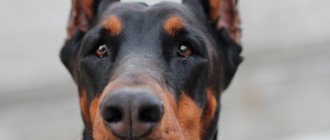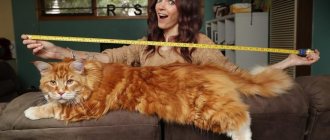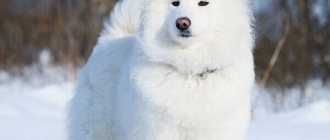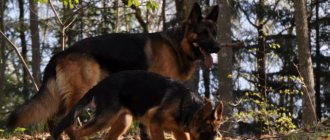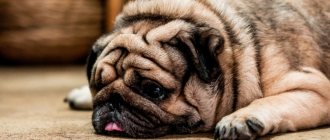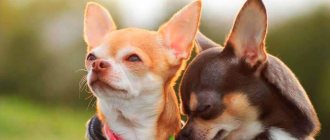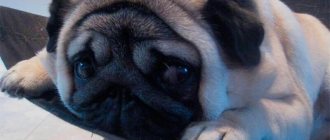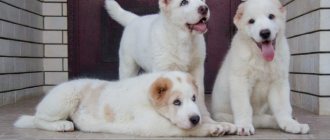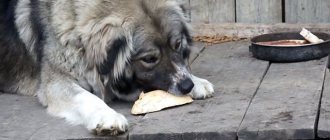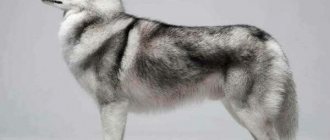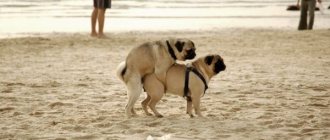Rottweilers are dogs characterized by their large size and powerful build.
It’s not for nothing that these strong, hardy dogs are called “athletes among dogs”: they really have great strength and power, which makes early education and socialization absolutely necessary.
Even in puppyhood, Rottweilers look quite massive, and as the dog grows, this trend continues to persist.
What size should a representative of this breed be and how quickly does a Rottweiler gain height and weight depending on its age?
History of the origin of the breed
The Rottweiler is classified as a German dog, but the true history of the origin of the breed goes back to ancient times. It is not known for certain; the most widespread version is that dogs were faithful companions of Roman legionnaires. They herded herds, took part in battles and dog fights (from about the 1st century BC), and guarded settlements.
Julius Caesar, in one of his notes, mentions the ferocious dogs that fought against his legionnaires during the battle in Britain. These data are confirmed by frescoes with images of warrior dogs that have survived to this day. The ancestors of modern Rottweilers were used by people in the territories of Assyria, Babylon, and Ancient Egypt.
The turning point in the development of the breed was the German city of Rottweil, built by Roman traders. There were fairs here where livestock, grain, flour, and meat were sold. Warehouses had to be guarded and trade caravans had to be protected along the way. It was then that fearless, hardy gladiator dogs began to be actively used, from which modern Rottweilers came.
In the Middle Ages there were two types of breed:
- larger individuals guarded houses and warehouses and transported cargo. Due to their enormous size, bite force, and extremely vicious nature, such dogs could not participate in herding;
- Smaller dogs were used precisely as shepherds; they differed from their massive counterparts in mobility and endurance.
Later, the work of breeders combined the best qualities of these two varieties into one dog. This is how the modern Rottweiler appeared - a harmoniously built dog, smart, strong, and infinitely loyal. Due to the peculiarities of the main field of activity of the inhabitants of the Rottweiler’s homeland, representatives of the breed were called “butcher’s dogs.” There is a legend that local merchants transferred money by hanging wallets around the necks of their pets. So they were calm about their income, which hardly anyone would dare to encroach on.
The popularity of the breed began to grow in 1910, when the merits of Rottweilers were appreciated by the First German Union of Police Dogs. The dogs spread beyond the borders of Germany, and over the next twenty years they became popular in Europe, Australia, and the USA.
The first individuals appeared in Russia in 1914. The mass import was organized at the state level in 1924, when cynologists from law enforcement agencies created a domestic guard breed - the black terrier, in whose veins, among others, the blood of the Rottweiler was supposed to flow. The dogs were kept in departmental kennels and began to reach amateur dog breeders only in the post-war years.
“Soviet” Rottweilers differed from their European counterparts in their much more ferocious disposition; some had lightened coat colors. Systematic breeding of the breed started in the 1970s. By the end of the 1980s, the defects introduced by the experiments were eliminated.
What does a Rottweiler look like, description of the breed with photos
The Rottweiler breed standard does not imply division into subspecies, but there are some differences between individuals selected by different canine associations. Unofficially, there are three main types of Rottweilers:
- German - classic, most consistent with the approved characteristics;
- The English version is externally similar to the German one, but British breeders, when breeding, focused on adjusting the dog’s character. These individuals retain their protective qualities, but are more balanced and calm;
- US dog handlers followed the Soviet path. The American Rottweiler is distinguished by its more massive physique and aggressiveness.
Dogs from different breeding lines differ slightly. Thus, Finnish Rottweilers have an elongated muzzle, while Australian ones are slightly lower, leaner, “Norwegians” are taller than their relatives.
Despite minor differences, the breed standard (last edition dated 2000) provides for the following characteristics of a purebred dog:
- medium length skull;
- the ears are triangular in shape, medium in size, set wide apart, close to the cheekbones;
- the transition from forehead to muzzle is pronounced;
- the muzzle is wide, tapering towards the nose;
- lobe black with large nostrils;
- lips fit tightly to the gums, pigmented black;
- scissor bite;
- number of teeth: 22 on the lower jaw, 20 on the upper jaw;
- eyes dark brown;
- the neck is powerful, of medium length;
- limbs with developed muscles, the hind limbs are wider apart than the front ones.
At present, the attitude towards cupping is ambiguous. The feasibility of the operation has not been confirmed. A long tail does not bother dogs; short ears do not reduce the risk of a pet getting otitis media.
In some countries, the procedure is prohibited; dogs with cropped ears and tails are not accepted for participation in exhibitions. In Russia, both options are allowed. The tail is docked up to the second vertebra (inclusive). An undocked one in an alert state continues the line of the spine, in a calm state it is lowered down.
Size and weight
Representatives of the breed give the impression of powerful, large dogs. Males are much more massive than females. The weight of a male Rottweiler is about 50 kg, and that of a female is about 42 kg.
Standard height at withers:
- 61-68 cm – for males;
- 56-63 cm – for females.
Please note: there are no miniature Rottweilers! Unscrupulous breeders are passing off defective puppies for them. Such individuals often have physiological or mental disorders.
The standard body length is 118-138 cm. In a purebred dog, the proportion of height to body length is 1:2.
Color and coat type
The Rottweiler's coat should be short and rough to the touch. The undercoat is completely hidden by the center hair. Long-haired individuals with soft or wavy hair are considered defective.
As for color, until 1923 the requirements were less stringent. Red, dark gray, and brindle coat colors were considered acceptable.
Today only one is recognized - black and tan. There are quite a lot of requirements placed on it. The tan marks should be clearly defined and of various shades (from golden to red-brown).
The spots are located:
- on eyelids;
- on the cheeks;
- on both sides of the muzzle;
- on the lower part of the neck;
- triangle on the sternum;
- under the tail;
- on the forelimbs.
Too large an area of scorch markings is a breed defect. Some people confuse the Rottweiler and the Golden Retriever, but they are completely different dogs.
Deviations from the standard
Defects
Any, even small, deviations from the standard can be counted as flaws. Each deviation is considered by the judges individually.
The following parameters are considered defects:
- poorly developed muscles of the dog’s trunk;
- non-standard physique: light or vice versa - too heavy;
- elongated or shortened muzzle;
- narrow or lightweight skull;
- poorly defined stop;
- saggy jowls;
- shaved without black pigmentation;
- narrow jaws;
- low set ears;
- erect position of the ears;
- eyes are not almond shaped;
- elongated or shortened neck;
- folds on the neck;
- narrow, long or vice versa – short body;
- uneven back line;
- strongly sloping croup;
- barrel-shaped chest;
- tail set low or too high;
- undeveloped muscles of the limbs;
- soft wool;
- too big sun spots.
Disqualifying faults
The defects that can permanently end a Rottweiler's exhibition career include the following deviations from standard parameters:
- a male behaves like a female and vice versa;
- cowardice;
- uncontrolled aggressiveness;
- shyness;
- unbalanced psyche;
- not brown eye color;
- eye diseases, such as cataracts or strabismus;
- not a scissor bite;
- incomplete set of teeth;
- coat is too long;
- curly hair or with a slight wave;
- non-standard color;
- white tan spots.
Share with us in the comments how old your dog is and how much it weighs. Does your pet meet the standard?
Health and illness
Representatives of this breed have fairly good health. Among them, the most common are genetic pathologies associated with disorders of the nervous system. Such as epilepsy, encephalitis.
Rottweilers, like most large breeds, have articular dysplasia. It can be congenital or acquired. The reasons for the latter may be:
- obesity;
- injuries;
- lack of movement;
- improper feeding;
- excessive physical activity.
It is possible to notice the disease in time by carefully observing your pet. You should immediately consult a doctor if your dog begins to limp, his limbs are positioned incorrectly when running, and he frequently stops to rest while walking. Dysplasia can be treated surgically or medically.
Of the ophthalmological abnormalities, Rottweilers are characterized by:
- conjunctivitis;
- glaucoma;
- cataract;
- turn of the century.
The breed is susceptible to skin pathologies caused by hormonal imbalances, allergic reactions, and metabolic disorders. Among them:
- dermatitis;
- eczema;
- acne;
- seborrhea.
Disturbances in the gastrointestinal tract in Rottweilers are usually associated with improper nutrition of the dog, poisoning while walking, when the dog eats something from the ground. A pet that is fed unbalancedly may develop diseases of the genitourinary system in adulthood.
Lifespan
The average lifespan of a Rottweiler is short - 8-12 years . Some individuals live 15 years. There are cases where representatives of the breed lived to be 17, but this is an exception.
Vaccination helps prolong a pet's life. The breeder should give the puppy his first vaccinations at 1.5-2 months. Revaccination is necessary up to six months. After one year of age, the dog is vaccinated annually.
You need to be vaccinated against diseases such as:
- rabies;
- leptospirosis;
- parainfluenza;
- adenovirus;
- parvovirus enteritis.
The vaccination schedule is drawn up by a veterinarian. A couple of weeks before the procedure, the dog needs to be dewormed.
To what age do they grow?
Small Rottweilers weigh only 300-500 grams at birth . Thus, by the time the puppy finally reaches adulthood, it should gain ten times the weight it originally had.
What is their growth chart?
Already in the first month of life, the baby gains from two to four kilograms . In the future, his rapid gain in weight and height slows down and such rapid leaps no longer occur.
However, by three or four months of age, a Rottweiler puppy's weight, if healthy and developing properly, should increase fivefold. And by five months, a puppy, as a rule, already weighs only half as much as the weight of an adult dog.
NOTE!
Representatives of this breed grow in height up to about a year, and later, up to two years, or even longer, they gain muscle mass and, accordingly, weight.
In bitches, growth often stops or even stops completely with the onset of the first heat..
After this, she can grow another couple of centimeters, but then she will only increase in breadth, while gaining muscle mass.
Character and intelligence
The purebred Rottweiler has a calm, balanced disposition and a stable nervous system. These pets will not spoil things in the apartment or dig holes in the garden. Dogs have developed intelligence, the ability to make independent decisions, they feel like full members of the “pack”.
It is important for a Rottweiler to have only one owner. Dogs accept and protect all family members, but they will only obey one person. To do this, the owner must prove to the dog that he is the absolute leader. The dog is well aware of its power and demands respect. Violence will cause retaliatory aggression, the animal will become uncontrollable and will constantly prove its superiority.
Attention: a dominant Rottweiler is extremely dangerous to others!
The breed cultivated protective qualities; the dogs are fearless and endlessly devoted to their owner. They love attention and praise. “Gingerbread” is the surest way to achieve the desired result from a dog.
Breeders pay attention to obedience and mental stability of the offspring during the selection process. To cull nervous, aggressive dogs, there is a special two-step test:
- First, the dog and the owner are placed in a place where strangers gather. They do not behave threateningly, but move around the subjects, surround them, and approach the owner. If the dog reacts calmly to their actions, the first stage has been completed;
- at the second stage, the dog is required to demonstrate protective qualities. The dog grabs the protective sleeve of the “aggressor”, who imitates blows to the dog’s body with his second hand. In this exercise, it is important that at the first request of the owner, the pet lets go of his hand and moves into a waiting position.
If stress resistance tests are passed, the dog is allowed for breeding.
Attitude towards children and others
A properly raised Rottweiler behaves peacefully, even affectionately, with members of the household. Dogs treat their owner's children kindly. They will not purposefully harm the baby, but problems may arise due to their size - with an awkward movement, the dog can push the child and cause him pain. In addition, children should be taught how to handle animals. The Rottweiler tolerates discomfort for a long time, but if you constantly pull it by the tail or get into its eyes, it may not be able to withstand it. You should not leave dogs of this breed alone with a small child.
Dogs are friendly towards people they know and treat strangers calmly, but warily. They will carefully watch them, not missing a single detail. At the slightest sign of a threat, they immediately, harshly attack, regardless of the danger. After the contraction they immediately calm down.
The attitude towards other dogs depends entirely on the quality of training. The Rottweiler has a natural desire for dominance. In a well-mannered animal, unmotivated aggression towards relatives is weakly expressed. This can only be achieved through early socialization. The puppy should begin to communicate with dogs as early as possible, preferably non-aggressive breeds. Then the society of his relatives will be perceived calmly by him even in adulthood.
Lifespan of a dog
Of course, how many years Rottweilers live depends primarily on how the owner cares for the animal. The average age of dogs of this breed is eight to ten years. In general, Rottweilers, like other large breeds of dogs, are not considered to be long-lived. But if the owner follows certain care rules, Rottweilers will live for many more years.
The life expectancy of dogs of this breed depends on the presence of the following factors:
- good pedigree – heredity affects the health of the animal;
- proportionate physical activity;
- daily active walks in the fresh air;
- properly balanced diet;
- timely rest;
- constant communication with the owner - the Rottweiler cannot be alone for a long time.
If the owner properly maintains the dog, loves and respects it, then the Rottweiler can become his faithful friend and devoted guard, living a long and happy life.
Now let’s look at the Rottweiler parameters that are included in the breed standard.
Training and education
Despite the fact that the Rottweiler belongs to the category of service dogs, their training requires serious effort and skill. It is better to raise a dog together with a specialist. For those who decide to train their pet on their own, it is advisable to take several lessons that will help you learn optimal communication with your dog.
The basic rules of behavior in the house must be instilled in the puppy, starting from the first day. They must be carried out unquestioningly and be consistent. Rottweilers are very smart, independent, and self-confident. They will only obey a person they respect. Moreover, often the puppy chooses its owner for itself. The dogs perceive the rest of the family members as needing care; they do not have authority.
First of all, your pet needs to be taught to sleep in its place. In order for the puppy to quickly learn to go to the toilet on the street, it is worth taking him out for a walk immediately after eating, encouraging the baby for urinating outside the home.
After all the vaccinations, you need to walk your Rottweiler as much as possible and practice the “come to me” command. It is intended not only to call the animal - it is a way to control the pet when it is at a distance from the owner. This ensures the safety of others and the dog himself. You need to call him by name several times, repeating the order. For completing a task, the dog must be praised and given a treat every time.
They begin to master the “sit” command before eating. When the baby sits in front of the bowl on his own, you should practice the skill outside.
Another important command is “fu”, which cancels any unwanted actions of the pet. The orders “no” and “quit” have a similar meaning. The latter is relevant in situations where the dog is trying to eat something while walking.
Breeders note that the reaction of Rottweilers is somewhat slow. They take longer to analyze the command and take action than other breeds. You can’t rush; you need to master skills gradually moving from one task to another. You cannot give several commands at the same time - the dog will get confused.
But once a Rottweiler masters a skill, he will not forget it throughout his life. After mastering the basic training course, you can begin SKD.
Attention: representatives of this breed do not forgive violence!
Dogs are cunning and vindictive, so you can’t physically punish them, but you shouldn’t baby them either. This is a serious dog that requires firmness. Thanks to their developed intelligence, they respond well to intonation and love their owner. They will obey in order to please the owner and receive praise.
Basic moments
- Rottweilers reach full physical and psychological maturity by two years.
- They require long walks combined with active games and physical activity.
- They need a serious and strong mentor. They will create a lot of problems for inexperienced owners who do not have the skills to work with service dogs.
- Rottweilers do not tolerate high temperatures well, but they feel quite comfortable in the cold, thanks to their dense undercoat.
- They recognize the dominant role of the owner, but absolutely do not accept violence against themselves.
- They are smart, capable of making decisions with lightning speed if there is a threat to human life and health.
- They have a good appetite, thanks to which they are able to quickly “eat up” extra pounds and lose shape.
- They get along well with the pets they grew up with.
- Small dogs and puppies are treated with indifference and contempt. They sense rivals in large individuals, often provoking them into a fight.
- Animals that have not completed the mandatory training course are usually uncontrollable and pose a danger not only to others, but also to their own owner.
Pros and cons of the breed
When deciding to purchase a Rottweiler, it is extremely important to weigh the pros and cons, evaluate your strengths and capabilities to provide the pet with proper upbringing. A table of positive and negative traits of the breed will help you make your choice.
| pros | minuses |
| sharp mind | stubbornness |
| devotion | desire for dominance |
| easy to care for | requires regular exercise walking |
| developed protective instinct | the likelihood of unmotivated aggression |
| ability to train | ability to train |
| unpretentiousness in food | tendency to obesity |
Negative characteristics of the breed are mostly associated with flaws in training or keeping the dog.
Maintenance, care and nutrition
Content
The Rottweiler is suitable for living in a city apartment or country house, but it requires personal space. The bedding should be hard and spacious so that the dog does not develop bedsores. The dog's place should be located in a part of the house from where the pet can see family members. The Rottweiler will refuse to be in an isolated corner. He needs to spend time with people.
The breed is not suitable for keeping outside. The dog will need a warm kennel, but if the outside temperature is below -10°C, it needs to be taken indoors. Despite their thick undercoat, these dogs do not tolerate cold well, catch colds easily, and can get colds in their kidneys.
Attention: you cannot keep your Rottweiler on a chain! This threatens the development of mental problems for the dog.
This breed needs serious physical activity to develop muscle mass and release accumulated energy. You should walk for at least an hour, twice a day. Sedate walks in the park are not suitable for a Rottweiler. He needs jogging and active games. It is advisable to visit dog parks, where, in addition to working on simulators, the dog can communicate with other dogs and learn to exist in society.
Care
The Rottweiler is not very difficult to care for. The wool does not need cutting or trimming. A couple of times a week, the dog is brushed with a brush or rubberized mitten. During the molting period (autumn and spring), combing should be done as a daily procedure. Bath the dog a maximum of four times a year, using a special shampoo. The use of human detergents can cause skin problems and dandruff.
Other hygiene procedures include:
- regularly inspect your ears, remove accumulated wax with a cotton pad soaked in a weak solution of hydrogen peroxide or a special animal solution. If pus is found in the sinks, consult a doctor immediately;
- periodically wipe the eyes with chamomile infusion or weak tea;
- Teeth should be brushed every week with a finger brush or special bones (they are sold in pet stores). Neglect of this procedure leads to periodontal disease and stone formation;
- claws are trimmed as needed. It is advisable to entrust this manipulation to a specialist, since according to the breed standard they are black, it is difficult to find the place to cut, and the capillaries can be damaged.
Nutrition
It is better to feed your Rottweiler up to a year with ready-made super premium food for fast-growing breeds. It maintains a balance of substances and contains all the necessary vitamins and microelements that ensure the full development of the dog’s body. In addition, such food is easy to prepare and has a long shelf life.
Suitable brands include:
- Belcando;
- Brit;
- Bosch;
- Eukanuba.
It should be borne in mind that small Rottweilers are very gluttonous and continue to beg for more even when they are full. They cannot be indulged; the breed has a tendency to become obese. It is necessary to strictly follow the dosage of food indicated on the packaging.
After a year, the Rottweiler can be switched to natural feeding. Your dog's diet should include:
- meat (except pork);
- buckwheat;
- vegetables;
- cottage cheese;
- offal;
- rice;
- eggs;
- millet;
- fruits;
- dairy products;
- barley grits;
- sea fish (once a week).
When feeding your pet at home, you should be given vitamin and mineral complexes prescribed by a veterinarian. Once a day you should add a spoonful of vegetable oil to your food - this will improve the animal’s digestion. The Rottweiler requires bones and cartilage to develop its jaws.
It is forbidden to give the dog:
- legumes;
- bread;
- milk;
- sweets;
- sausage
- potato;
- dishes from the host's table.
Two-month-old puppies are fed six times a day, gradually reducing the number of meals to three.
Periods of development
Newborn puppies weigh 450-700 g. By the end of the first month of life, they increase approximately 5-6 times. This is the most active period of development. By the second month, the puppy gains about a quarter, and by the fifth, half of its maximum weight.
Newborn babies are black, with barely noticeable markings. Their paws are still small and weak, but already have noticeable claws. The ears are pressed to the head, and the eyes do not see anything.
Further development is divided by dog handlers into periods:
- Infant (1-7 weeks). A one-month-old baby is in dire need of maternal care. He is just learning to use his senses, use his paws, tail, mouth.
- Adaptation (4-7 weeks). Puppies become active and restless: they learn to run and communicate, and actively get to know people and the outside world.
- Socialization (7-12 weeks). The beginning of raising and training a pet: they show the boundaries of what is permitted, teach commands, behavior with people, dogs, and other animals.
- Dominance (12-17 weeks). The young dog becomes strong and independent, which is why he wants to command the “pack”: it is important for the owner to show firmly, but without beating or intimidation, that the man is in charge.
- Independence (4-8 months). The owner patiently teaches the dog the correct behavior and does not allow it to dominate people.
- Period of fear (8-14 months). An animal can be frightened by a seemingly harmless thing, which affects its psyche. The owner, together with the dog, overcomes its fears and makes it clear that the person can always be relied upon.
The mental development of a Rottweiler continues up to 2-4 years. Having reached puberty, the dog may again become nervous and disobedient. The owner stops bad behavior in time, shows his dissatisfaction, but does not use physical violence.
How to choose a puppy
You should only buy a Rottweiler from specialized nurseries or qualified breeders. They monitor the purity of the breed and pay attention to the selection of balanced, mentally stable individuals.
You need to decide on the gender of your pet. Raising a male dog is much more difficult. They will always compete with humans for leadership positions. Bitches are more affectionate, more devoted, less aggressive. But they require serious care during pregnancy (lasts about 60 days) and childbirth.
For those who do not plan to participate in exhibitions and breeding, you can choose a pet-class puppy. They are inferior only in appearance, but become excellent friends and reliable guards.
It is advisable to purchase a puppy between the ages of one and three months, when all the advantages and disadvantages of the dog are noticeable. In addition, raising a Rottweiler from childhood is much easier than raising an adult dog.
When choosing a purebred individual, you need to pay attention to the following points:
- the umbilical hernia cannot be felt;
- limbs straight;
- strong skeleton;
- eyes and ears are clean, without discharge;
- nose is black;
- in a male dog both testicles are descended;
- the wool is clean;
- wide muzzle;
- dewclaws are docked;
- the back is flat;
- gums and lips are darkly pigmented;
- irises dark brown;
- the skin is clean, without irritation and dandruff, pink on the tummy, gray on the rest of the body;
- tail without creases;
- claws black;
- color black with pronounced red tan markings.
A Rottweiler puppy should be inquisitive, active, playful, not hide, and not show aggression.
You need to ask the breeders about the achievements of the parents of the future pet, check all the necessary documents, and observe the behavior of the adult dog. A responsible breeder will ask the potential buyer a lot of questions, and may refuse to sell the puppy if he believes that the person will not be able to cope with the dog’s character.
The cost of a Rottweiler varies depending on the region and exhibition prospects, starting from 15,000 rubles. The upper price limit is difficult to determine. You can buy a puppy from an ad on the Internet much cheaper, but it’s not worth the risk. There is a high risk of getting a dangerous animal with an unbalanced psyche.
Rottweiler sizes by month
A table of Rottweiler growth by month is provided, which perfectly illustrates the active development of the pet. Growth of a Rottweiler puppy is most active before 6 months and reaches relative stability starting at 9 months. The dog's body undergoes the most active growth during the first 3-4 months. It is important at this time to monitor the animal’s diet, filling it with all the necessary vitamins and minerals.
| Puppy age | Puppy weight (male/female) | Puppy height (male/female) |
| 1 month | 3.5/4.5 kg | 20/22 cm (height at withers) |
| 2 months | 8/9 kg | 33/29 cm |
| 3 months | 17/14 kg | 47/48 cm |
| 4 months | 23/17 kg | 51/51 cm |
| 5 months | 31/24 kg | 56/56 cm |
| 6 months | 35/30 kg | 60/59 cm |
| 7 months | 40/34 kg | 64/61 cm |
| 8 months | 46/36 kg | 66/62 cm |
| 9 months | 50/36 kg | 66/62 cm |
| 10 months | 50/36 kg | 67/63 cm |
| 11 months | 50/38 kg | 67/63 cm |
| 12 months | 50/40 kg | 67/63 cm |
At the age of 3 months, the volume of the chest of a male Rottweiler reaches 60 cm, and that of a female - 55 cm. At 4 months, the figures change to 66 cm and 60 cm, respectively, at 5 months - to 76 cm in both a male and a female. By six months, the male’s chest volume becomes 77 cm, while the female’s is 79. From 7 to 12 months of life, the male Rottweiler’s chest grows from 78 to 90 cm, and the female’s – from 81 to 85 cm.
Rottweiler puppies, photo from Victor Miroshnienko.
The Rottweiler, whose size is formidable, is prone to obesity, so its nutrition must be carefully monitored. The table provided on the website corresponds to breed standards. If the individual indicators of the animal do not correspond to it, you must contact a specialist. To gain weight, you should increase the caloric content of the diet; if there is an excess, on the contrary, transfer the dog to a diet food.
Source
